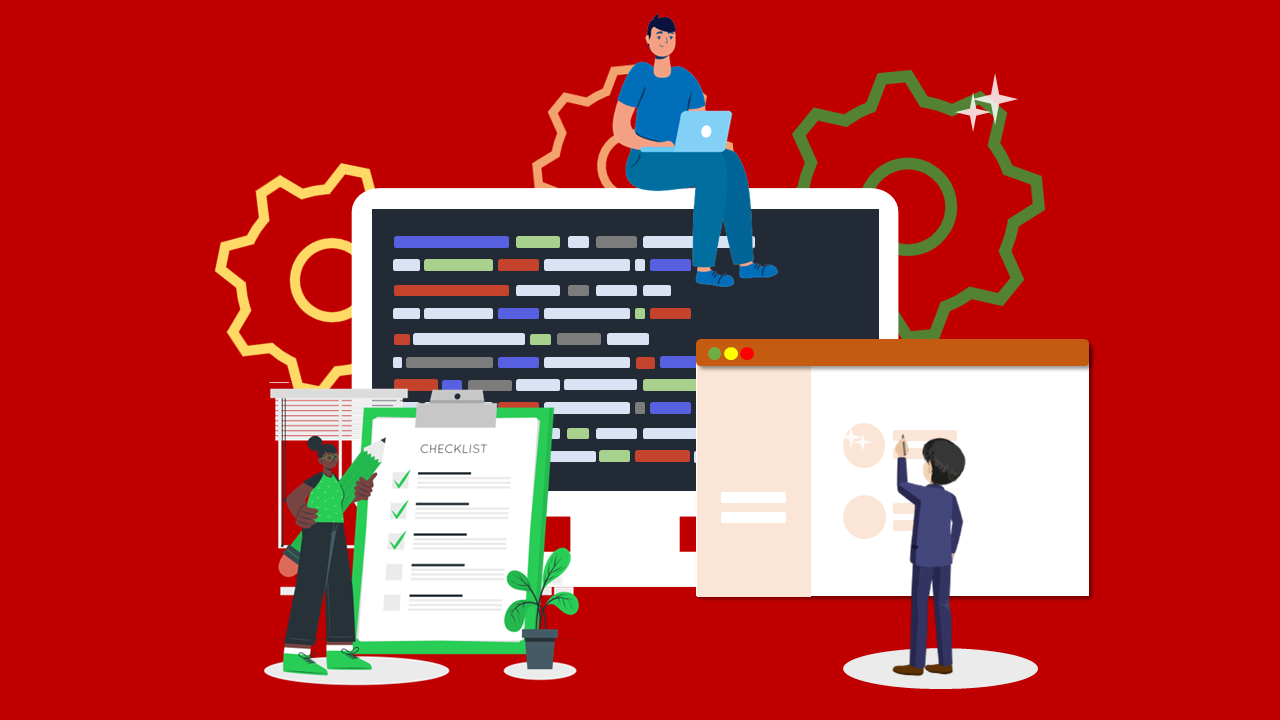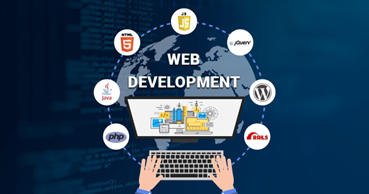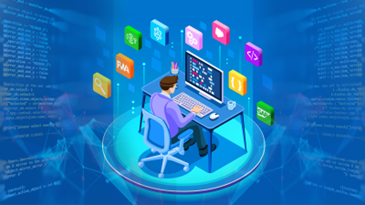
Differences between Web development and Software development
With the rapid growth of computer programming, many phrases used to describe different aspects of programming have not had the time to acquire consistent meanings. As a result, some of these phrases are frequently used interchangeably, sometimes causing misunderstanding. For instance, consider software development with web development. Web development and software development can both signify quite similar things. The two terms may be slang for “coding” or “development.”
Overview of Web and Software Development
Web development focuses on creating and maintaining websites and web applications. It encompasses everything from building simple, static web pages to complex, interactive web applications. Web developers work on a website’s appearance, layout, and, in some cases, content. The field is further divided into two main areas: front-end development, which deals with the part of a website a user interacts with, and backend development, which involves the server side of a website, database management, and application logic.
On the other hand, software development is a broader field that includes the process of conceiving, specifying, designing, programming, documenting, testing, and bug-fixing involved in creating and maintaining applications, frameworks, or other software components. Software developers create programs for standalone desktop environments, mobile devices, or network-based systems. Unlike web development, software development often involves building offline applications that do not necessarily rely on a web browser.
Defining Web Development
Web development is the process of building, creating, and maintaining websites and web applications that run online on a browser. It ranges from developing simple, static pages of plain text to complex web-based applications, social network services, and electronic business applications. The field encompasses several aspects: web design, web content development, client-side/server-side scripting, and network security configuration. Here are some key characteristics of web development.
- Dynamic Content Creation: Web development centres on creating dynamic and interactive content. This involves building websites that respond and adapt to user input, making the user experience more engaging and personalised.
- Client-Server Model: It typically follows a client-server model, where the server hosts the website and the client, usually a web browser, interacts with it.
- Accessibility and Responsiveness: A crucial aspect is ensuring websites are accessible and responsive across various devices and screen sizes, enhancing user experience and accessibility.
- Interactivity: Incorporating elements that engage users, like forms, comment sections, and interactive graphics, is a significant part of web development.
- Search Engine Optimisation (SEO): Optimising websites for search engines to improve visibility and ranking is integral to web development.
- Content Management: It often involves content management system (CMS) development and customisation, enabling non-technical users to easily update and manage their websites.
Common Tools and Technologies
With its dynamic and versatility, web development continues to evolve, requiring developers to stay updated with the latest technologies and practices. It’s a field where creativity meets technical skills, enabling developers to bring innovative ideas to life on the digital canvas.
- HTML/CSS/JavaScript: The foundational technologies for building web pages. HTML structures the content, CSS styles it and JavaScript adds interactivity.
- Frameworks and Libraries: JavaScript frameworks (like Angular, React, and Vue.js) and CSS frameworks (like Bootstrap and Foundation) are commonly used for faster and more efficient development.
- Backend Languages: PHP, Ruby, Python, and Node.js are used for server-side development.
- Databases: Knowledge of databases like MySQL, MongoDB, and SQL Server is essential for storing and managing data.
- Version Control/Git: Tools like Git help track code changes and collaborate with other developers.
- Content Management Systems (CMS): Platforms like WordPress, Drupal, and Joomla allow for creating and managing digital content without needing to write code from scratch.
- Web Servers: Understanding web servers such as Apache and Nginx is important for hosting and serving web applications.
- Responsive Design Tools: Tools and techniques for creating responsive designs ensure that websites work well on various devices and screen sizes.
- APIs (Application Programming Interfaces): Integrating third-party APIs for functionalities like maps, payment gateways, and social media integration.
- Testing and Debugging Tools: Tools like Chrome DevTools, Jest, and Selenium are used to test and ensure web application quality.
Defining Software Development
Software development involves conceiving, specifying, designing, programming, documenting, testing, and bug-fixing in creating and maintaining applications, frameworks, or other software components. It encompasses a wide range of activities, from developing simple desktop programs to complex systems for businesses and organisations.
Unlike web development primarily focused on websites and web applications, software development can include creating desktop applications, mobile apps, system software, and networked systems. Here are some key characteristics of software development
- Diverse Application Areas: Software development spans various industries and applications, from commercial and business applications to entertainment, healthcare, and scientific research.
- Complex Problem Solving: It often involves addressing complex problems and creating solutions that optimise efficiency and performance.
- Lifecycle Methodologies: Involves methodologies such as Agile, Waterfall, and DevOps, which guide the development process from ideation to deployment and maintenance.
- Scalability and Performance: Build software that scales and performs efficiently under varying loads and conditions.
- Security Considerations: Emphasises the importance of security in the software development process, particularly for applications that handle sensitive data.
- Cross-Platform Development: Involves creating software that can operate on various operating systems and hardware platforms.
- User Interface and Experience: Prioritises user interface (UI) and user experience (UX) design, ensuring the software is user-friendly and meets the needs of its target audience.
Common Tools and Technologies
Software development is a field that combines technical expertise, creativity, and problem-solving skills. It is vital in advancing technology and providing innovative solutions across various sectors. With the rapid pace of technological advancements, the scope and impact of software development continue to grow, shaping how we interact with technology in our daily lives.
- Programming Languages: Includes languages such as Java, C#, Python, C++, and many others, each suited for different types of software development.
- Integrated Development Environments (IDEs): Tools like Eclipse, Visual Studio, and IntelliJ IDEA offer comprehensive facilities for software development.
- Version Control Systems: Systems like Git and SVN are essential for tracking code changes, especially in collaborative environments.
- Database Management Systems: Knowledge of databases like MySQL, Oracle, and Microsoft SQL Server is crucial for data-driven applications.
- Testing Tools: Tools like JUnit, Selenium, and TestComplete are used for automated testing to ensure software quality.
- Build Tools and CI/CD Pipelines: Tools like Jenkins, Maven, and Gradle are used to automate the building, testing, and deployment of software.
- Cloud Platforms: Familiarity with cloud platforms like AWS, Azure, and Google Cloud Platform is increasingly important for modern software development.
- Containerisation and Virtualisation: Technologies like Docker and Kubernetes are important for creating scalable and portable software environments.
- Project Management Tools: Tools like Jira and Trello help manage the software development lifecycle and track progress.
- API Development Tools: Tools like Postman and Swagger are widely used for creating and managing APIs.
Comparative Analysis: Web vs Software Development
While web and software development share common ground regarding technology and skills, they diverge significantly in their purpose, functionality, development methodologies, and user interface considerations. Understanding these differences is crucial for professionals in making informed career choices and for businesses in selecting the right technology strategy.
| Aspect | Web Development | Software Development |
|---|---|---|
| Purpose | – Online presence and interactivity<br>- E-commerce, information dissemination, social networking | – Broad range of purposes including desktop and mobile apps, system software |
| Functionality | – Requires internet connectivity<br>- Cross-platform compatibility via web browsers | – Can operate offline<br>- Tailored to specific OS/platforms |
| Development Process | – Combination of front-end and back-end development<br>- Iterative, requires constant updates | – Phases include requirement gathering, design, implementation, testing, maintenance |
| Methodologies | – Agile and DevOps for rapid deployment and updates | – Agile, DevOps, and traditional models like Waterfall |
| User Interface (UI) | – Responsive design for accessibility across devices | – Tailored to specific OS, focuses on native look and feel |
| User Experience (UX) | – Emphasises ease of navigation, quick loading, and accessibility | – Focuses on seamless, intuitive experience and device integration |
Technical Skills Required
These skill sets highlight the specialised nature of web and software development while emphasising the valuable shared competencies in both fields.
| Skill Category | Web Development Skills | Software Development Skills | Overlapping Skills |
|---|---|---|---|
| Core Programming | HTML, CSS, JavaScript | Advanced languages like Java, C#, C++, Python | – |
| Design | Responsive Web Design | – | Basic UI/UX Principles |
| Frameworks | Front-end frameworks (e.g., React, Angular, Vue.js) | – | – |
| Backend Languages | Node.js, Ruby, Python, PHP | – | – |
| Database Management | SQL, MySQL, MongoDB | Advanced database design and optimisation | – |
| Content Management | Experience with CMS like WordPress, Drupal, Joomla | – | – |
| Optimisation | SEO, Web Performance Optimisation | – | – |
| APIs | RESTful API Integration | – | Understanding and creation of APIs |
| Testing/Debugging | – | Automated and manual testing, software debugging | Basic Testing and Debugging Skills |
| System Design | – | System architecture and design | – |
| Platform-Specific Development | – | Desktop and mobile development (iOS, Android) | – |
| Cloud Services | – | AWS, Azure, Google Cloud | – |
| Security | – | Cybersecurity, encryption technologies | – |
| Version Control | Basic use of Git | Advanced use of Git for complex software projects | Basic knowledge of Git |
| CI/CD | – | Continuous Integration/Continuous Deployment (CI/CD) pipelines | – |
| Methodologies | – | – | Familiarity with Agile practices |
| Project Management | – | – | Project management skills |
| Communication | – | – | Effective communication skills |
| Adaptability | – | – | Learning and adaptability in evolving technologies |
How Web Development Complements Software Development
While distinct in their primary focus and methodologies, web development and software development often complement each other in the broader context of technology and digital solutions. The intersection of these two fields can lead to enhanced functionalities, broader accessibility, and innovative solutions.
- Enhanced Functionalities: Software development can benefit from web development by integrating web interfaces and web-based technologies. For example, traditional software applications can incorporate web-based user interfaces, allowing remote access and cloud-based functionalities.
- Accessibility and Reach: Web development extends the reach of software applications by enabling access from any device with a web browser. This accessibility allows software developers to target a wider audience without the constraints of platform-specific development.
- Cloud Computing and SaaS: The rise of cloud computing and software as a Service (SaaS) models is a perfect example of this interplay. Software developers can leverage web technologies to deliver applications as a service over the internet, offering scalable, on-demand software solutions.
- Data Interchange and APIs: Web development provides tools and protocols (like RESTful APIs) that enable software applications to communicate and exchange data over the web. This interchange is crucial for integrating different systems and services, enhancing the capabilities of standalone software.
- Mobile Applications and Web Services: With the increasing prevalence of mobile devices, software developers often need to integrate web services into mobile applications. Web developers, in turn, need to ensure these services are optimised for mobile platforms, providing a seamless user experience.
Conclusion
In this web and software development exploration, we’ve seen that while they share a common technological foundation, they diverge significantly in purpose, methodologies, and skill sets. Web development primarily focuses on creating browser-based applications, emphasising accessibility, user interaction, and front-end aesthetics.
In contrast, software development encompasses a broader range of applications, including desktop and mobile apps, emphasising complex problem-solving, system architecture, and platform-specific optimisation. At ARCC, we specialise in both software and website development services. Connect with us to learn more about how we can support your digital and technological needs.








